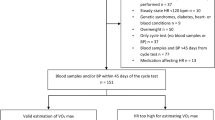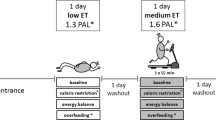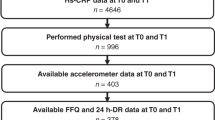Abstract
Objective:
To examine differences in cardiovascular fitness (VO2max) and physical activity levels in overweight Hispanic children with normal glucose tolerance (NGT) vs impaired glucose tolerance (IGT).
Participants:
A total of 173 overweight (BMI percentile 97.0±3.1) Hispanic children ages 8–13 years with a family history of type 2 diabetes.
Methods:
VO2max was measured via a maximal effort treadmill test and open circuit spirometry. Physical activity was determined by questionnaire. Glucose tolerance was established by a 2-h oral glucose challenge (1.75 g of glucose/kg body weight). IGT was defined from an oral glucose tolerance test as a 2-h plasma glucose level ⩾140 and <200 mg/dl.
Results:
IGT was detected in 46 of the 173 participants (∼27%); no cases of type 2 diabetes were identified. No significant differences were found between youth with NGT and those with IGT in absolute VO2max (2.2±0.6 vs 2.1±0.5 l/min), VO2max adjusted for gender, age, and body composition (2.2±0.2 vs 2.1±0.2 l/min), or recreational physical activity levels (8.7±8.2 vs 6.9±6.2 h/week).
Conclusion:
Overweight Hispanic youth with IGT exhibit similar levels of VO2max and physical activity compared to their NGT counterparts. Longitudinal analyses are necessary to determine whether fitness/activity measures contribute significantly to diabetes risk over time in this group.
This is a preview of subscription content, access via your institution
Access options
Subscribe to this journal
Receive 12 print issues and online access
$259.00 per year
only $21.58 per issue
Buy this article
- Purchase on Springer Link
- Instant access to full article PDF
Prices may be subject to local taxes which are calculated during checkout

Similar content being viewed by others
References
Ogden CL, Flegal KM, Carroll MD, Johnson CL . Prevalence and trends in overweight among US children and adolescents, 1999–2000. JAMA 2002; 288: 1728–1732.
Goran MI, Bergman RN, Avila Q, Watkins M, Ball GD, Shaibi GQ et al. Impaired glucose tolerance and reduced beta-cell function in overweight Latino children with a positive family history for type 2 diabetes. J Clin Endocrinol Metabol 2004; 89: 207–212.
Sinha R, Fisch G, Teague B, Tamborlane WV, Banyas B, Allen K et al. Prevalence of impaired glucose tolerance among children and adolescents with marked obesity. N Engl J Med 2002; 346: 802–810.
Wiegand S, Maikowski U, Blankenstein O, Biebermann H, Tarnow P, Gruters A . Type 2 diabetes and impaired glucose tolerance in European children and adolescents with obesity – a problem that is no longer restricted to minority groups. Eur J Endocrinol 2004; 151: 199–206.
Meigs JB, Muller DC, Nathan DM, Blake DR, Andres R, Baltimore Longitudinal Study of A. The natural history of progression from normal glucose tolerance to type 2 diabetes in the Baltimore Longitudinal Study of Aging. Diabetes 2003; 52: 1475–1484.
Thamer C, Stumvoll M, Niess A, Tschritter O, Haap M, Becker R et al. Reduced skeletal muscle oxygen uptake and reduced beta-cell function: two early abnormalities in normal glucose-tolerant offspring of patients with type 2 diabetes. Diabetes Care 2003; 26: 2126–2132.
Wei M, Gibbons LW, Mitchell TL, Kampert JB, Lee CD, Blair SN . The association between cardiorespiratory fitness and impaired fasting glucose and type 2 diabetes mellitus in men. (Erratum appears in Ann Intern Med 1999 Sep 7;131(5):394). Ann Internal Med 1999; 130: 89–96.
Takemura Y, Kikuchi S, Inaba Y, Yasuda H, Nakagawa K . The protective effect of good physical fitness when young on the risk of impaired glucose tolerance when old. Prevent Med 1999; 28: 14–19.
Ball GD, Shaibi GQ, Cruz ML, Watkins MP, Weigensberg MJ, Goran MI . Insulin sensitivity, cardiorespiratory fitness, and physical activity in overweight Hispanic youth. Obes Res 2004; 12: 77–85.
Marshall WA, Tanner JM . Variations in the pattern of pubertal changes in boys. Arch Dis Child 1970; 45: 13–23.
American Diabetes Association: clinical practice recommendations 2002. Diabetes Care 2002; 25 (Suppl 1): S1–S147.
Ku CY, Gower BA, Hunter GR, Goran MI . Racial differences in insulin secretion and sensitivity in prepubertal children: role of physical fitness and physical activity. Obes Res 2000; 8: 506–515.
Kriska AM, Knowler WC, LaPorte RE, Drash AL, Wing RR, Blair SN et al. Development of questionnaire to examine relationship of physical activity and diabetes in Pima Indians. Diabetes Care 1990; 13: 401–411.
Baan CA, Stolk RP, Grobbee DE, Witteman JC, Feskens EJ . Physical activity in elderly subjects with impaired glucose tolerance and newly diagnosed diabetes mellitus. Am J Epidemiol 1999; 149: 219–227.
Clausen JO, Borch-Johnsen K, Ibsen H, Bergman RN, Hougaard P, Winther K et al. Insulin sensitivity index, acute insulin response, and glucose effectiveness in a population-based sample of 380 young healthy Caucasians. Analysis of the impact of gender, body fat, physical fitness, and life-style factors. J Clin Invest 1996; 98: 1195–1209.
Simoneau J-A, Kelley DE . Altered glycolytic and oxidative capacities of skeletal muscle contribute to insulin resistance in NIDDM. J Appl Physiol 1997; 83: 166–171.
Rowland TW, Boyajian A . Aerobic response to endurance exercise training in children. Pediatrics 1995; 96: 654–658.
Rowland TW . The role of physical activity and fitness in children in the prevention of adult cardiovascular disease. Prog Pediatr Cardiol 2001; 12: 199–203.
Gutin B, Owens S, Treiber F, Islam S, Karp W, Slavens G . Weight-independent cardiovascular fitness and coronary risk factors. Arch Pediatr Adolescent Med 1997; 151: 462–465.
Ivy JL . Role of exercise training in the prevention and treatment of insulin resistance and non-insulin-dependent diabetes mellitus. Sports Med 1997; 24: 321–336.
Schmitz KH, Jacobs Jr DR, Hong CP, Steinberger J, Moran A, Sinaiko AR . Association of physical activity with insulin sensitivity in children. Int J Obes Related Metabolic Disorders: J Int Assoc Study Obes 2002; 26: 1310–1316.
Bunt JC, Salbe AD, Harper IT, Hanson RL, Tataranni PA . Weight, adiposity, and physical activity as determinants of an insulin sensitivity index in pima Indian children. Diabetes Care 2003; 26: 2524–2530.
Bailey RC, Olson J, Pepper SL, Porszasz J, Barstow TJ, Cooper DM . The level and tempo of children's physical activities: an observational study. Med Sci Sports Exercise 1995; 27: 1033–1041.
Gortmaker SL, Must A, Sobol AM, Peterson K, Colditz GA, Dietz WH . Television viewing as a cause of increasing obesity among children in the United States, 1986–1990. Arch Pediatr Adolescent Med 1996; 150: 356–362.
Acknowledgements
We are grateful to the project coordinator, Quintilia Avila, and to the nurses and nutrition staff at the USC-GCRC. Additionally, we express our gratitude to the children and their families for making this study possible. This work was supported by National Institutes of Health Grant R01 DK 59211 and by GCRC, National Center for Research Resources, Grant M01 RR 00043.
Author information
Authors and Affiliations
Corresponding author
Rights and permissions
About this article
Cite this article
Shaibi, G., Ball, G., Cruz, M. et al. Cardiovascular fitness and physical activity in children with and without impaired glucose tolerance. Int J Obes 30, 45–49 (2006). https://doi.org/10.1038/sj.ijo.0803171
Received:
Revised:
Accepted:
Published:
Issue Date:
DOI: https://doi.org/10.1038/sj.ijo.0803171



